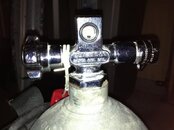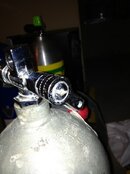You are using an out of date browser. It may not display this or other websites correctly.
You should upgrade or use an alternative browser.
You should upgrade or use an alternative browser.
What kind of valve is this?
- Thread starter guruboy
- Start date
Please register or login
Welcome to ScubaBoard, the world's largest scuba diving community. Registration is not required to read the forums, but we encourage you to join. Joining has its benefits and enables you to participate in the discussions.
Benefits of registering include
- Ability to post and comment on topics and discussions.
- A Free photo gallery to share your dive photos with the world.
- You can make this box go away
J-Valve. Used before SPGs. Shut off the tank at approx 500 psi and you turned the thing down to reserve to get the last 500 psi and end your dive.
OP
So that's what a J-valve looks like!
Thanks.
Any reason not to use it?
Thanks.
Any reason not to use it?
Not particularly. I picked up a 1980s aluminum 50cf tank with one on it. I only use it in the pool and have an SPG so it isn't ever a problem (I like small tanks for the pool, just because). Neat way to show the J-valve to students too. As long as you have gauges you'll know how much air you've got I'd say it isn't an issue. I'm sure someone will say it's old and might need to be rebuilt and all of that but as long as it works fine then I'd say you're good to go. Just know how to use it in case you do get down there in pressure. They aren't all exact when it comes to the reserve part. Mine flips over at only 300psi...
Just keep the switch in the down position when you fill and dive. Really no reason to avoid using it if the valve is in working order and the knobs aren't sticky or stiff to turn.
If they are sticky and stiff, it's nothing a service shouldn't be able to take care of; assuming that's all.
The only issue today with a working J-valve is on the fill operator's end, if he/she is not familiar with J-valves. Common error is filling your empty tank with the switch in the up position. Basically without going into detail, the fill operator will get a mis-reading on your tank pressure and assume it's full when in fact it's not. The lines will be full but the tank will not be. You have to fill with the switch down in reserve, then if you wanted you could flip the switch to up after the tank has been filled. Traditionally this was done because:
1) no SPG's
2) it signaled a full tank
If the error is made, the error can be caught by simply using an pressure gauge or reg set to check your tank pressure. Also if your fill operator is diligent, they'll see your empty tank fill way too fast; although they won't know why if they're not familiar w/ the J-valve.
A little bit of history:
Originally there's a thick metal gauge wire with one end that connects to the valve and the other onto a retainer indent on the back of your metal tank bracket of your backpack. On your dive, once your tank went "dry" the first time, you'd unhook the wire from the tank band then pull down to activate your J-valve in reserve and hope that it was in fact not already down, otherwise you'd get a chance to put all those CESA sessions to actual-practical use.
OR as others have morbidly put it: "You get the rest of your life to pull off one CESA."
If all went well and you toggled the switch down, you'd end your dive using your remaining reserve of 500psi, or 300psi. [Depending on who you talk to, some say the reserve was set at 300psi for valves.]
Back then "Air Checks" during a dive meant reaching back and checking to see if the J-valve was still toggled up. Although I'm sure they didn't call it that back then.
Now days we use BCs with nylon webbing tank straps. So no way to retain the metal wire without fashioning something yourself. Alternatively you can just reach over your shoulder and activate the reserve yourself, if possible. Most times you don't find J-valves with the original metal wire attached, at least in my experience.
And additionally since you have an SPG and are monitoring your air, it be better to just have the reserve already in play so if you needed to use it, you'd have one less motion to go through to be able to use it.
If they are sticky and stiff, it's nothing a service shouldn't be able to take care of; assuming that's all.
The only issue today with a working J-valve is on the fill operator's end, if he/she is not familiar with J-valves. Common error is filling your empty tank with the switch in the up position. Basically without going into detail, the fill operator will get a mis-reading on your tank pressure and assume it's full when in fact it's not. The lines will be full but the tank will not be. You have to fill with the switch down in reserve, then if you wanted you could flip the switch to up after the tank has been filled. Traditionally this was done because:
1) no SPG's
2) it signaled a full tank
If the error is made, the error can be caught by simply using an pressure gauge or reg set to check your tank pressure. Also if your fill operator is diligent, they'll see your empty tank fill way too fast; although they won't know why if they're not familiar w/ the J-valve.
A little bit of history:
Originally there's a thick metal gauge wire with one end that connects to the valve and the other onto a retainer indent on the back of your metal tank bracket of your backpack. On your dive, once your tank went "dry" the first time, you'd unhook the wire from the tank band then pull down to activate your J-valve in reserve and hope that it was in fact not already down, otherwise you'd get a chance to put all those CESA sessions to actual-practical use.
OR as others have morbidly put it: "You get the rest of your life to pull off one CESA."
If all went well and you toggled the switch down, you'd end your dive using your remaining reserve of 500psi, or 300psi. [Depending on who you talk to, some say the reserve was set at 300psi for valves.]
Back then "Air Checks" during a dive meant reaching back and checking to see if the J-valve was still toggled up. Although I'm sure they didn't call it that back then.
Now days we use BCs with nylon webbing tank straps. So no way to retain the metal wire without fashioning something yourself. Alternatively you can just reach over your shoulder and activate the reserve yourself, if possible. Most times you don't find J-valves with the original metal wire attached, at least in my experience.
And additionally since you have an SPG and are monitoring your air, it be better to just have the reserve already in play so if you needed to use it, you'd have one less motion to go through to be able to use it.
OP
Great info. Thanks.
No wire on this one. it did come on a pretty old steel tank with a very minimal backplate and harness attached that used a metal tank band though.
No wire on this one. it did come on a pretty old steel tank with a very minimal backplate and harness attached that used a metal tank band though.
If it's made of plastic, that would be the backpack I was referring to.
Can't really use those as modular backplates unfortunately.
It's different to go vintage and dive like they did in the old days, back when skin diving and scuba diving were truly interchangeable terms because the only difference was whether you held your breath or not underwater. Lots of limitations and more risks though. Wouldn't recommend you use that backpack till much much later in your career and after a good mentoring from a "vintage" diver.
Can't really use those as modular backplates unfortunately.
It's different to go vintage and dive like they did in the old days, back when skin diving and scuba diving were truly interchangeable terms because the only difference was whether you held your breath or not underwater. Lots of limitations and more risks though. Wouldn't recommend you use that backpack till much much later in your career and after a good mentoring from a "vintage" diver.
captain
Contributor
You might also see a clip on the metal tank band for the J valve pull rod. J valves also makes it easier to carry a tank. All my tanks have J valves mostly for that reason.
dfx
Contributor
This got me curious... With the switch in the up position, what does an SPG read? The actual tank pressure, or ~500 psi less than that?
neonstingray
Contributor
- Messages
- 215
- Reaction score
- 24
Back when my mom started diving she had a faulty J-valve that led to her running out of air and having to buddy breath with my grandfather.
Similar threads
- Replies
- 16
- Views
- 1,516
- Replies
- 3
- Views
- 232





